As China has contained the novel coronavirus (COVID-19) outbreak ahead of other countries, the Chinese economy is recovering. Despite the stagnation of the global economy, China, with its supply capacity surpassing domestic demand, is increasing exports to foreign markets facing supply shortages due to the effects of lockdowns. The ensuing expansion in China's trade surplus, coupled with the depreciation of the U.S. dollar against major currencies, is pushing up the Chinese yuan's exchange rate.
In 2021, China's economic growth rate measured in terms of real gross domestic product (GDP) is expected to stay at around an annualized rate of around 6% on a quarter-on-quarter basis, a performance commensurate with the country's potential growth rate. However, on a year-on-year basis, the GDP growth rate may reach a double-digit number, reflecting the significant "carry-over effect" resulting from the sharp rise in GDP toward the end of 2020. The year-on-year growth rate in 2021 is expected to follow a pattern of "starting high and ending low," reversing the pattern of "starting low and ending high" observed in 2020. In the first quarter in particular, the economic growth rate is expected to be as high as around 20%.
Chinese Economy Ahead of the Rest of the World in Recovery
The COVID-19 outbreak, which started in China at the beginning of 2020, later grew into a global pandemic. As China took such anti-COVID-19 measures as promoting testing for infection and imposing rigorous restrictions on the movement of people in contaminated areas, the outbreak in the country was contained around March 2020 (Figure 1). Since the beginning of 2021, small clusters of infection have been observed, but a further deterioration of the situation is likely to be avoided as the government is taking stricter measures than before. Meanwhile, outbreaks in other countries have yet to be contained.
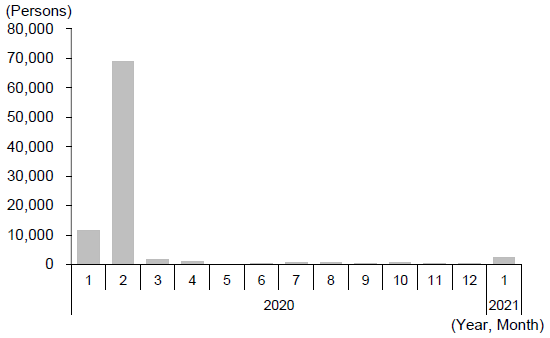
Under these circumstances, while the global economy has fallen into a serious recession, the Chinese economy is one step ahead in recovering (Figure 2). In China, the GDP growth rate (year-on-year) fell to minus 6.8% in the first quarter of 2020, but the Chinese economy achieved a V-shaped recovery, recording positive growth rates of 3.2% in the second quarter, 4.9% in the third quarter and 6.5% in the fourth quarter. These numbers translated into an annual growth rate of plus 2.3% for 2020as a whole. In contrast, the economic growth rates (year-on-year) of the U.S. the European Union (EU), and Japan dropped even more sharply in the second quarter of 2020 than that of China in the first quarter, and stayed in negative territory in the rest of 2020.
—Following the Spread of COVID-19 Infection—
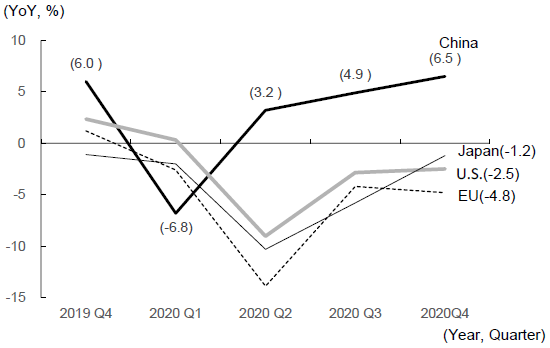
Thanks also to the appreciation of the Chinese yuan (to be mentioned later), the size of China's GDP relative to U.S. GDP grew from 66.6% in 2019 to 70.4% in 2020. As a result, the timing of China's GDP overtaking U.S. GDP is likely to come earlier than the widely expected 2030 (Note 1).
Expansion of China's Net Exports Reflecting the Asymmetry between the Supply-demand Imbalances in China and Other Countries
In China, despite the higher economic growth rate than in other countries, net exports (exports minus imports) are increasing, as the growth in exports is higher than the growth in imports (Figure 3). This phenomenon reflects the asymmetry between the supply-demand imbalances in China and other countries. In China, supply is outpacing demand as production recovers ahead of demand, whereas in other countries, demand is outpacing supply as demand picks up earlier thanks to the implementation of large-scale economic stimulation packages. The increase in China's net exports is offsetting the gaps between supply and demand on both sides.
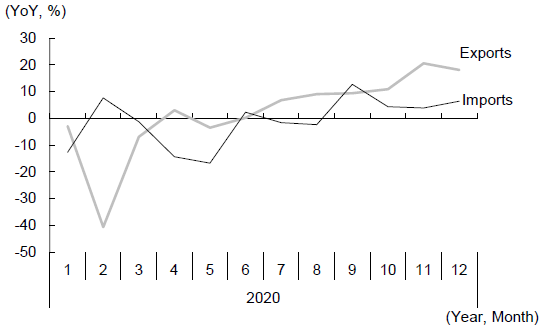
In China, the contribution of net exports to the GDP growth rate, which, along with the contributions of investment and consumption, became negative (all measured year-on-year and in real terms) in the first quarter of 2020, has turned positive since the second quarter, reaching 1.4% in the fourth quarter (Figure 4).
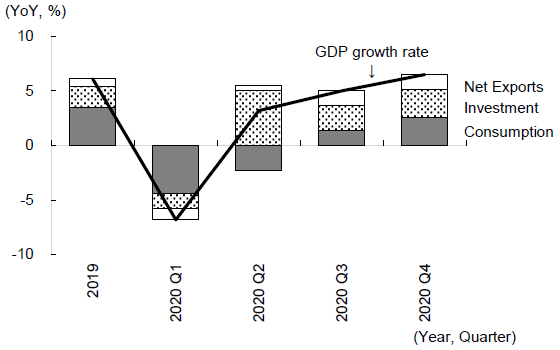
Yuan Pushed Up by Improvement in China's International Balance of Payments
Between June 2020 and January 2021, the Chinese yuan's exchange rate against the U.S. dollar rose around 10%, and its effective exchange rate (the weighted average relative to a basket of currencies of trading partner countries; BIS, Effective Exchange Rate) also rose 5%. An improvement in the international balance of payments, including the trade balance, coupled with the dollar's depreciation, is pushing up the yuan's exchange rate.
On the trade front, reflecting a much higher rate of growth for exports than for imports, China's trade surplus (customs-clearance basis) in April-December 2020 amounted to 524.9 billion dollars, about 50% higher than the surplus in the same period of the previous year (348.4 billion dollars).
As for direct investment, for security reasons, other countries have introduced strict restrictions on cross-border investments to protect their domestic industries against Chinese companies' merger and acquisition (M&A) activities. As a result, Chinese outward foreign direct investment has become sluggish. On the other hand, as the Chinese government devotes efforts to attracting foreign capital through the easing of foreign equity restrictions, inward foreign direct investment in China continues to increase. Consequently, China's surplus in the direct investment account is growing.
Regarding the travel account, China was previously recording large deficits because the number of outbound tourists was higher than the number of inbound tourists and also because the amount of per-capita spending by outbound tourists was larger. However, as international tourism has virtually come to a halt due to the continuing COVID-19 outbreaks outside China, China's travel account deficit is narrowing.
In addition to the improvement in the international balance of payments, the dollar's depreciation against major currencies is accelerating the rise in the yuan's exchange rate. Against the backdrop of the United States' aggressive monetary easing and the shrinkage of the spread between interest rates in the United States and other countries, the dollar is falling not only against the yuan but also against other major currencies, with the result that the dollar's effective exchange rate fell around 10% between April 2020 and January 2021.
Year-on-year Growth Rate in 2021 Expected to Start High and End Low
In 2021, China's GDP growth rate is expected to be very high, reflecting the significant "carry-over effect" brought about by the sharp rise in GDP toward the end of 2020. To check on this point, I developed an index to track the trend in quarterly real GDP based on quarter-on-quarter growth data (seasonally adjusted) published by the National Bureau of Statistics of China and, based on this index, I projected year-on-year GDP growth rates in the whole of 2021 and in each quarter of the year in two cases, one (Projection 1) assuming 0% growth and the other (Projection 2) assuming a growth rate of 1.5% on a quarter-on-quarter basis (Figure 5).
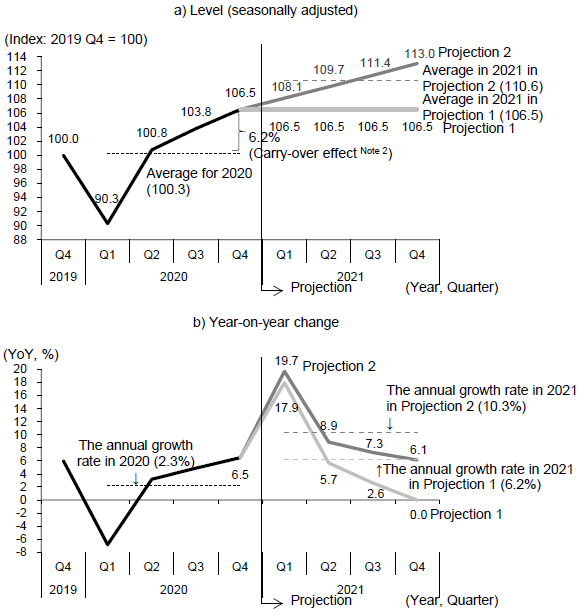
1. The assumed quarter-on-quarter growth rate is 0% for Projection 1 and 1.5% for Projection 2.
2. The "carry-over effect" represents the difference between the level of GDP in the final quarter of the previous year and the average level of quarterly GDP in the previous year as expressed in percentage terms.
3. As the annual growth rate was calculated based on the average of the quarterly indexes, it does not necessarily match the figure obtained through calculation based on the indexes in the corresponding quarters, or with the average of the year-on-year growth rates in the corresponding quarters (because of the rounding effect).
China's GDP growth rate fell to minus 9.7% in the first quarter of 2020 on a quarter-on-quarter basis but rebounded to 11.6% in the second quarter and thereafter stayed relatively high-3.0% in the third quarter and 2.6% in the fourth quarter. When expressed in index form, with the figure for the fourth quarter of 2019 used as the base of 100, the level of GDP comes to 90.3% in the first quarter of 2000, 100.8 in the second quarter, 103.8 in the third quarter, and 106.5 in the fourth quarter. The level of the index in the fourth quarter is 6.2% higher than the average in 2020 (100.3). The difference of 6.2% corresponds to the magnitude of the "carry-over effect" that boosts the economic growth rate in 2021.
As for quarterly GDP growth, even based on the assumption of 0% growth on a quarter-on-quarter basis (the absolute level remains at 106.5, the same as the level in the fourth quarter of 2020), the projected year-on-year growth rate stands at 17.9% in the first quarter, 5.7% in the second quarter, 2.6% in the third quarter and 0% in the fourth quarter, with the annual growth rate coming to 6.2% (Projection 1), which corresponds to the "carry-over effect."
China's potential annual growth rate is presumed to be around 6% (or around 1.5% on a quarter-on-quarter basis), so let us calculate projected year-on-year growth rates based on this more realistic assumption. In that case, the projected level of quarterly real GDP (indexed basis) stands at 108.1 (up 19.7% year-on-year) in the first quarter, 109.7 (up 8.9% year-on-year) in the second quarter, 111.4 (up 7.3% year-on-year) in the third quarter, and 113.0 (up 6.1% year-on-year), with the annual average coming to 110.6 (up 10.3% from the average in the whole of the previous year) (Projection 2).
Thus China's quarterly GDP growth rate in 2021 measured on a year-on-year basis is expected to shift from the pattern of "starting low and ending high" in 2020 to the mirror-image pattern of "starting high and ending low." Moreover, the annual average growth rate may exceed 10% for the first time since 2010, when the economy was recovering from the Lehman crisis in response to a massive economic package worth 4 trillion yuan.
However, such a high growth rate would be nothing more than a temporary phenomenon representing a rebound during the recovery phase of the business cycle, and it is unlikely to continue in 2022 and beyond. To maintain a high level of growth rate over the medium to long term, China must carry out further structural reforms, mainly on the supply side (See Box).
BOX: Key Economic Policy Missions Presented at the Central Economic Work Conference
Because of the increasingly acute labor shortage at home and the rise of protectionism abroad, China's economic growth rate has declined steeply in recent years. To deal with this problem, China has set forth a "dual circulation" strategy, which aims to ensure that the domestic and international circulations mutually promote each other, with the domestic circulation as the main body. In line with this strategy, at a meeting of the Central Economic Work Conference on December 16-18, 2020, the following eight points were presented as the key missions in 2021.
- (i) Strengthen national strategic technologies.
- (ii) Strengthen China's independent ability to control industrial supply chains.
- (iii) Maintain the expansion of domestic demand.
- (iv) Comprehensively promote reform and opening and positively consider participating in the Comprehensive and Progressive Agreement for Trans-Pacific Partnership.
- (v) Resolve the problems of seeds and cultivated land in order to enhance food security.
- (vi) Strengthen anti-trust measures and prevent the disorderly expansion of capital. Enforcement is targeted mainly at Alibaba and other platform companies that have achieved rapid growth in recent years.
- (vii) Resolve the pronounced problems of residential housing in major cities, such as housing price upsurges.
- (viii) Take action toward achieving the CO2 emission reduction target (emission peak-out by 2030 and net zero emission by 2060).
The original text in Japanese was posted on February 8, 2021.


